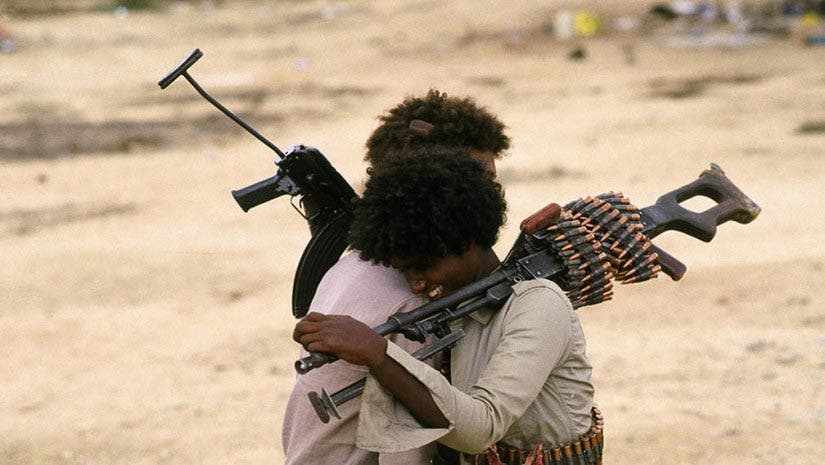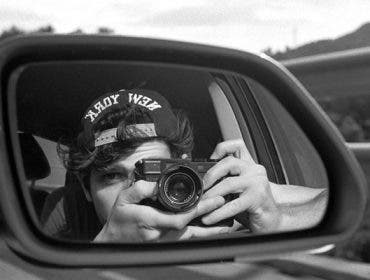Susan May Tell has traveled the world creating impassioned and incisive images for over 40 years. Her searing reportage of conflict zones and revealing portraits of heads of state have appeared in Time Magazine, the New York Times, and many other prestigious publications. In addition to her achievements as a photojournalist she has produced an impressive body of personal fine art images that embody the transcendent, lyrical quality of visual poetry. This latter work has been widely published, exhibited, and held in major collections, including the Smithsonian Museum’s famed Samuel Wagstaff Collection and has been shown at 7 major American institutions. More recently, Columbia University acquired Tell’s Catalog of Works and Oral History, and Art2Art began exhibiting her work alongside such legendary photographers as Ansel Adams, Diane Arbus, and Dorothea Lange.
“Basically, I was an artist looking for an art form, and I found it in photography,” she states with disarming directness. “My journey into photography began a long time ago and continues until this very moment. From 1983-85, I had the honor of befriending and being mentored by André Kertész, one of the greatest photographers of the 20th century. We pored over his prints and photographed together in Washington Square Park, and I will never forget what he said in response to viewing my photographs—‘You have the feeling. You have the composition.’ That may be the most concise description of why I take photographs.”
“Since what I’m actually doing can’t be explained in words,” Tell continues, “I don’t really have a technique, a method, or a mission statement and I’m not trying to say anything, in particular, other than conveying what I see and experience at a moment in time. When pressed for an answer, I say I took the picture because my ‘finger clicked,’ that is, when something I am experiencing is just right and there’s an irresistible force that says, ‘Take it!’ It’s like Bob Dylan’s memorable line, ‘…and you know something’s happening. But you don’t know what it is—do you, Mr. Jones.’ And I’ve come to understand the truth of Wallace Stevens’ trenchant observation, ‘The real is only the base. But it is the base.’ You need to have a place to stand if you expect to connect the spatial-temporal with the infinite, the eternal that is beyond space and time.”
Between 1986 and 1994 Susan May Tell was based in Cairo and Paris, spending four years in each location. During that time, she accepted commissions and was on assignment for the world-class publications mentioned above. When she returned to New York City, her hometown and now her home base, she spent a decade as a staff photographer and photo editor at the New York Post, before being inexorably and irresistibly drawn back to concentrating exclusively on her personal work.
“My approaches to commissioned vs. personal work have similarities and differences, including the equipment I use,” says Tell. “As I said, to me personal photographs are poems that don’t need to mean anything or require explanation. Just as every poem is about poetry, a successful photograph has to be about photography–form and feeling, not one or the other—but working together as equals, simultaneously vying for attention, giving the image a life of its own. It’s not about anything—it IS. It has to captivate me, intrigue me, and be something I could live with on my wall. On the other hand, commissioned work entails communicating information to the client (and its audience) about something in particular and it is an explanation in the largest sense of the word. I feel blessed to have been able to do both, especially as a woman photojournalist. The poetry of renowned imagist poets William Carlos Williams and Wallace Stevens, remain another ever-present influence on my work. This interconnection was reinforced on a recent fellowship to The MacDowell Colony in Peterborough, New Hampshire (the oldest artists’ colony in the U.S.) when two resident poets were inspired to write poems after seeing my photographs. That’s probably the highest form of praise there is.”
What equipment does Susan May Tell use to create her transcendent images? Again, much depends on the operational context. Here are some of her insightful thoughts on her approaches to shooting personal and commissioned work.
“When shooting for myself, and hopefully for the ages-:), I keep things simple, because the less I have to think about equipment the better. I use one camera body, the Leica M6, and one Leica lens, the 35mm f/2 Summicron. If it’s an extended trip, I’ll bring a back-up body, a Leica M2, and plenty of Kodak Tri-X Pan film, which I rate at ISO 200, overexposing it by one stop, and then under-developing it to bring out more shadow detail. Shooting film is meditative; it slows down the process. I suspend disbelief, suspend judgment, and operate on faith. This allows (actually forces) me to just be where I am at the moment, to experience see and feel what’s actually there, and to follow my instincts. This process leads to surprises and adventures to be sure, but that’s the essence of creating art.”
“When shooting digital, many photographers seem to spend as much time “chimping”—that is, looking at the LCDs on the backs of their cameras—instead of what’s in front of them,” observes Tell. “This might be important when shooting commercial work with a digital camera. However, even so, time spent looking at an image you’ve already taken—the past—means taking time away from what’s happening in front of you at the moment–the present. The editing process should come later. During a recent six-week trip photographing in rural West Virginia, Ohio, and Pennsylvania I shot 75 rolls of film—all processed when I returned to New York City. Built-in suspense. What do these photographs reveal? I won’t know and can’t know if I will like what I’ve shot until these photographs are printed!”
“By the way, although I confess to being a film fanatic, I’m never without a digital point and shoot—to make visual notes and serve as a visual memory. When I acquired one a couple of years ago I chose the Sony RX100 II. It’s tiny and lightweight, but its most essential attribute was that it had the shortest shutter lag time. When I was shooting commissioned work, mostly as a photojournalist. I used 3 or more SLR bodies, mostly manual focus, manual exposure Nikons, Nikkor lenses ranging from 20mm to 300mm, and assorted tele-extenders, multiple flash units, tripods, monopods etc. My go-to film of choice was Fujichrome 100.
What was it like to shoot the iconic portrait of the late Iraqi dictator Saddam Hussein that appeared in numerous iterations on the covers of many major news magazines? “I was in Cairo when Saddam Hussein came to visit Hosni Mubarak, then president of Egypt,” recalls Tell. “I took this shot the day after Saddam arrived. He would habitually walk a few paces then stop momentarily, all the while surrounded by a scrum of security people carrying briefcases that probably contained machine guns. I was quite familiar with his facial gestures and I was thinking that he probably kept his mouth closed so the venom wouldn’t spew out! Anyway, he stopped amidst a group of people, and I had made damn sure I was standing in a good position to get a full facial shot of him. I believe this image conveys something visceral and malevolent about his character and that’s what makes it effective and memorable. Incidentally, the published image is cropped; the full frame shows some of the people around him. I took the picture with a Nikon FM2 without motor drive and the 85mm f/1.8 Nikkor lens on Fujichrome 100 film. “
Finally, we asked Susan May Tell to explain the circumstances of one other poignant image in her journalistic portfolio, the incredible shot of two embracing fighters, both carrying automatic weapons and draped in ammo. “This was part of my documentation of the women fighters of the Eritrean Peoples’ Liberation Front (EPLF) for Life Magazine,“ says Tell. “It shows a man and woman fighter, who evidently knew each other and were overjoyed to see each other, spontaneously hugging right after a battle. I believe I shot it with a Nikon FM2 on Fujichrome 100 film, but I don’t remember which lens I used.” Like all of Susan May Tell’s images it has a timeless, lyrical quality that transcends the moment it depicts, transforming it into a visual impression destined to live forever in viewers’ hearts.

To learn more about Susan May Tell and see additional examples of her work please go to susanmaytell.com.



















